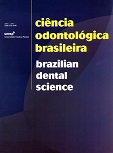Determination of osseoactivity gradients around two implant surfaces
DOI:
https://doi.org/10.14295/bds.2004.v7i4.206Abstract
A incorporação de biocerâmicas na superfície de implantes dentários tem sido utilizada na tentativa de se aumentar a resposta biológica aos materiais. O propósito desta investigação foi analisar gradientes de osseoatividade em função da distância da superfície de um implante com recobrimento de surperfície de baixa espessura depositado com auxílio de feixe iônico comparado a um implante com jateamento de óxido de alumínio/ banho ácido em 2 e 4 semanas de implantação em um modelo animal laboratorial. Quatro implantes foram colocados em cada tíbia, onde permaneceram por 2 e 4 semanas in-vivo. 10 mg/Kg de oxitetraciclina foram administradas como marcador biológico. As tíbias foram dissecadas e subsequentemente processadas para análise de fluorescência em microscópio. Quatro microfotografias (magnificação de 40 vezes, divididas em retângulos) foram tiradas ao redor de um dos lados do implante para quantificação da área marcada por tetraciclina em função da distância da superfície do implante, e equações lineares foram obtidas com a ajuda de um programa de computador. A quantificação da área marcada por tetraciclina (atividade óssea) mostrou valores maiores na região adjacente à superfície do implante para todos os grupos, e esses valores diminuiram com o aumento da distância. Os implantes com recobrimento de baixa espessura (grupo de 4 semanas) apresentaram maior atividade óssea em todas as distâncias. O intervalo até 0.5mm da superfície do implante foi a área de maior atividade óssea em todos os grupos, exceto no grupo de 4 semanas com recobrimento de baixa espessura, onde a área de maior atividade foi expandida até 1mm da superfície do implante. Equações lineares revelaram inclinações negativas de maior magnitude para recobrimento de baixa espessura durante os dois períodos avaliados. O gradiente de atividade ao redor dos implantes foi entre 0.5 e 1mm da superfície do implante e mostrou-se afetado pelo tratamento de superfície.
Downloads
Downloads
Published
How to Cite
Issue
Section
License
Brazilian Dental Science uses the Creative Commons (CC-BY 4.0) license, thus preserving the integrity of articles in an open access environment. The journal allows the author to retain publishing rights without restrictions.
=================




























